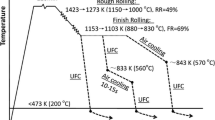Abstract
A technique allowing the rapid evaluation of the impact strength KCV of steels within the ductile–brittle transition temperature range is proposed in this work. A unified diagram of impact strength for different steels within the ductile-brittle transition range is built. A linear dependence \(\frac{{KC{V_T}}}{{KC{V_P}}} = f\left( {\frac{{KC{V_T}H{B_p}}}{{KC{V_T}H{B_T}}}} \right)\) is established within the temperature range of 77–473 K, where the subscripts T and p refer to the temperature of the impact strength to be estimated and the end temperature of the Peierls–Nabarro plastic deformation mechanism accordingly. The method for prediction of the impact strength is developed on the basis of the above diagram. It enabled us to reduce the number of needed tests and to gather information unavailable before because of the limited volume of material.
Similar content being viewed by others
References
The Use of Small-Scale Specimens for Testing Irradiated Material: ASTM STP 888, 1986.
Small Specimen Test Techniques Applied to Nuclear Reactor Vessel Thermal Annealing and Plant Life Extension: ASTM STP 1204, 1993.
Small Specimen Test Techniques: ASTM STP 1329, 1998.
Small Specimen Test Techniques: ASTM STP 1418, 2002, vol. 4.
Small Specimen Test Techniques: ASTM STP 1502, 2009, vol. 5.
Krasovsky, A.Ya. and Krasiko, V.N., Treshchinostoikost’ stalei magistral’nykh truboprovodov (Crack Resistance of Main Pipeline Steels), Kiev: Naukova Dumka, 1990.
Baron, A.A., A thermodynamic Model for Fracture Toughness Prediction, Eng. Fract. Mech., 1993, vol. 46, no. 2, pp. 245–251.
Frost, H.J. and Ashby, M.F., Deformation-Mechanism Maps: The Plasticity and Creep of Metals and Ceramics New York: Pergamon, 1982.
Borisenko, V.A., Tverdost’ i prochnost' tugoplavkikh materialov pri vysokikh temperaturakh (Hardness and Strength of Refractory Materials at High Temperatures), Kiev: Naukova Dumka, 1984.
Baron, A.A., The generalized diagram of fracture toughness for pipeline steels, Int. J. Pressure Vessels Piping, 2012, no. 98, pp. 26–29.
Baron, A.A. and Slyusareva, O.F., The Crack Resistance Diagram of Pipeline Steels, Izv. Volgograd. Gos. Tekh. Univ., Ser.: Probl. Materialoved., Svarki Prochnosti Mashinostr., 2012, no. 9(96), pp. 117–120.
Author information
Authors and Affiliations
Corresponding author
Additional information
Original Russian Text © A.A. Baron, S.A. Kunavin, 2015, published in Zavodskaya Laboratoriya, Diagnostika Materialov, 2015, Vol. 81, No. 9, pp. 67–70.
Rights and permissions
About this article
Cite this article
Baron, A.A., Kunavin, S.A. Prediction of the impact strength in steels in the transition temperature range. Inorg Mater 52, 1528–1531 (2016). https://doi.org/10.1134/S0020168516150024
Received:
Published:
Issue Date:
DOI: https://doi.org/10.1134/S0020168516150024




